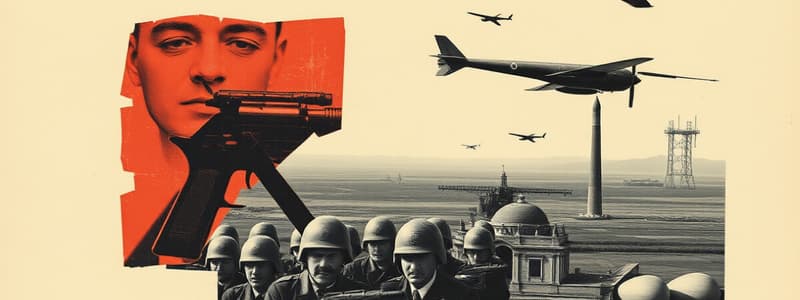Podcast
Questions and Answers
What does Mutually Assured Destruction (MAD) refer to?
What does Mutually Assured Destruction (MAD) refer to?
A doctrine of military strategy where full-scale use of nuclear weapons by opposing sides would lead to their complete annihilation.
What is the principle of Massive Retaliation?
What is the principle of Massive Retaliation?
A military doctrine promising to retaliate with much greater force in the event of an attack.
What is Brinkmanship?
What is Brinkmanship?
The practice of pursuing a dangerous policy to the limits of safety before stopping.
Who was Nikita Khrushchev?
Who was Nikita Khrushchev?
What was the Eisenhower Doctrine?
What was the Eisenhower Doctrine?
What is the Central Intelligence Agency (CIA)?
What is the Central Intelligence Agency (CIA)?
What does NASA stand for?
What does NASA stand for?
Who was Mao Zedong?
Who was Mao Zedong?
What geographic line represented the border between North and South Korea?
What geographic line represented the border between North and South Korea?
What is a satellite state?
What is a satellite state?
What was the Iron Curtain?
What was the Iron Curtain?
What was the Truman Doctrine?
What was the Truman Doctrine?
What does containment refer to in military strategy?
What does containment refer to in military strategy?
What is NATO?
What is NATO?
What was the Warsaw Pact?
What was the Warsaw Pact?
What does the term 'Red Scare' refer to?
What does the term 'Red Scare' refer to?
What was the House Un-American Activities Committee (HUAC)?
What was the House Un-American Activities Committee (HUAC)?
Who were the Hollywood Ten?
Who were the Hollywood Ten?
What does McCarthyism entail?
What does McCarthyism entail?
What benefits did the GI Bill of Rights provide?
What benefits did the GI Bill of Rights provide?
What is the Baby Boom?
What is the Baby Boom?
Flashcards are hidden until you start studying
Study Notes
Military Strategies and Doctrine
- Mutually Assured Destruction (MAD): A doctrine where full-scale nuclear warfare by opposing sides results in total annihilation of both parties.
- Massive Retaliation: A nuclear strategy where a state promises to use overwhelming force in retaliation for any attack.
- Brinkmanship: The tactic of pushing dangerous policies to the edge of conflict before backing down.
Key Figures in the Cold War
- Nikita Khrushchev: Former premier of the Soviet Union (1958-1964) known for promoting peaceful coexistence but also for instigating the Cuban Missile Crisis.
- Mao Zedong: Leader of the communist revolution in China, serving as chairman for 25 years and establishing communist rule.
Significant Policies and Doctrines
- Eisenhower Doctrine: U.S. policy aiming to provide military or economic aid to Middle Eastern countries resisting communism.
- Truman Doctrine: Established by President Harry S. Truman to contain Soviet influence, particularly in Greece and Turkey.
Organizations and Alliances
- Central Intelligence Agency (CIA): U.S. agency responsible for gathering and analyzing foreign intelligence for national security.
- National Aeronautics and Space Administration (NASA): U.S. government agency for aeronautics and space exploration.
- NATO (North Atlantic Treaty Organization): Military alliance formed on April 4, 1949, promoting mutual defense among member states.
- Warsaw Pact: A collective defense treaty among the Soviet Union and its satellite states during the Cold War.
Geographic and Political Divisions
- 38th Parallel: The dividing line between North and South Korea prior to the Korean War.
- Iron Curtain: The metaphorical boundary dividing Europe into the Western powers and Eastern communist nations from 1945 to 1991.
- Satellite States: Countries that maintain formal independence but are heavily influenced by a more powerful nation, particularly in the context of the USSR.
Social and Political Movements
- Red Scare: A period of heightened fear regarding communism and political radicalism in the U.S., particularly focused on the potential for a socialist revolution.
- House Un-American Activities Committee (HUAC): Investigative committee aimed at uncovering citizens with ties to Nazi ideology and later communist affiliations.
- Hollywood Ten: A group of filmmakers blacklisted for refusing to answer questions about their political beliefs regarding communism.
- McCarthyism: The practice of accusing individuals of subversion without credible evidence, often leading to political persecution.
Post-War Social Changes
- GI Bill of Rights: Legislation providing benefits, including education and housing, to World War II veterans, significantly impacting post-war American society.
- Baby Boom: A substantial rise in birth rates in the U.S. from 1946 to 1964, reflecting societal changes after WWII.
Studying That Suits You
Use AI to generate personalized quizzes and flashcards to suit your learning preferences.




